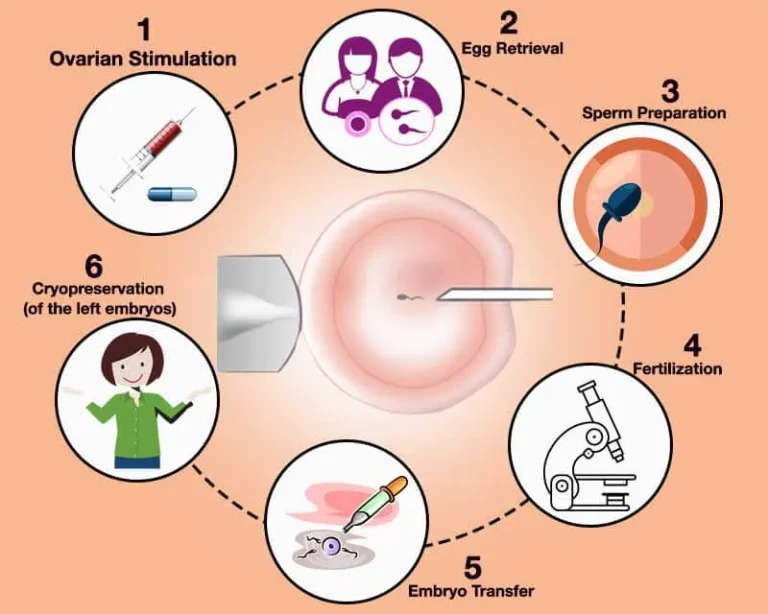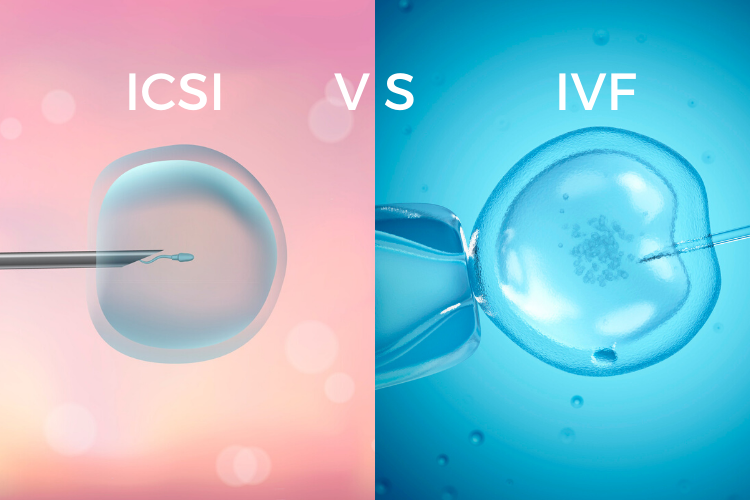Intracytoplasmic Sperm Injection (ICSI) in Iran
What is In Vitro Fertilization (IVF)

The details of ICSI

What is the difference between IVF and ICSI?
Intracytoplasmic Sperm Injection (ICSI)
Exploring the ICSI Procedure
Pre ICSI Procedures
• Physical Examination: Before embarking on the ICSI procedure, a comprehensive physical examination is conducted by the obstetrician to evaluate the health readiness of the mother-to-be. This includes a strategically timed blood test and ultrasound examination during the 2nd or 3rd day of the menstrual period. The results inform the dosage of hormones required for ovarian stimulation, considering factors such as physical health, age, and the outcomes of the physical exam.
• Ovarian Stimulation: Upon confirmation of readiness, the obstetrician initiates the ovulation induction process through daily hormone injections, stimulating the growth and maturation of multiple eggs for simultaneous fertilization. Typically, eggs reach full maturity 8-14 days after the initial hormone injection.
• Monitoring Oocyte Growth: Periodic transvaginal ultrasounds are performed to track the number of eggs and assess follicle growth. Subsequent hormone injections stimulate oocyte maturation in preparation for egg retrieval within 34–36 hours.
• Egg Retrieval: When eggs are deemed ripe for retrieval, the obstetrician conducts a minimally invasive procedure under light sedation. This involves inserting a thin needle through the vaginal wall, guided by ultrasound, to collect the eggs. The eggs are then transferred to an egg culture medium until ready for fertilization, with the entire process lasting approximately 20–30 minutes.
• Sperm Collection: On the same day as the female’s egg retrieval, the obstetrician schedules a sperm collection appointment for the male partner. If inconvenient, the male partner can provide sperm earlier, keeping it frozen until the female is ready for egg retrieval. To ensure optimal sperm quality, the obstetrician advises refraining from sexual activities, masturbation, and ejaculation for about 2-3 days before sperm collection.
On the day of sperm collection, the father-to-be with normal reproductive function is instructed to masturbate into a sterile container in a private room. Within 60 minutes, the ejaculate is sent to an embryology laboratory for semen analysis. The embryologist selects the healthiest and strongest sperm, nourishing them in a nutrient solution to enhance mobility before injecting them into the egg for fertilization. In cases of male-factor infertility with complete absence of sperm, alternative methods like Percutaneous Epididymal Sperm Aspiration/Testicular Sperm Extraction (PESA/TESE) are employed to retrieve sperm before facilitating fertilization.
Procedure during ICSI
• ICSI Fertilization: The embryologist carefully selects healthy mature eggs, placing them on a lab dish. An egg is firmly held in place with a pipette, and the healthiest sperm is drawn into the tip of a thin glass needle before being injected into the egg for fertilization.
• Embryo Culture: Following successful fertilization, the embryologist cultures the embryo for 3-5 days. The fertility doctor and embryologist monitor the embryo’s development through various cell division stages until it reaches the blastocyst stage on day five after fertilization. Embryos are cultured in a specialized nutrient solution under controlled laboratory conditions, mirroring the environment within the mother’s womb. This ensures optimal temperature, humidity, gases, and pH levels to facilitate embryo growth before proceeding with embryo grading and transfer procedures.
How is ICSI and IVF done?
Post ICSI Procedures
• Embryo Transfer: The transfer of embryos into the uterus occurs through either a fresh embryo transfer (ET) or a frozen embryo transfer (FET).
• Fresh Embryo Transfer (ET): This involves placing the embryo into the uterus during the same induction-ovulation cycle. Typically, the fertility doctor performs the embryo transfer 5–6 days after egg retrieval, once the embryo reaches the blastocyst stage. The embryo must exhibit good growth and development, and the mother-to-be’s condition must be pregnancy-ready. The fertility doctor uses a trans-abdominal ultrasound to guide the placement of the embryo into the uterine cavity for implantation and a safe pregnancy.
• Frozen Embryo Transfer (FET): This method delays the embryo transfer to a subsequent ovulation cycle, avoiding potential side effects like ovarian hyperstimulation syndrome (OHSS), endometrial hyperplasia, or edema. The embryo is frozen and thawed when the mother’s physical condition is ready for the transfer in a subsequent ovulation cycle.
• Pregnancy Test: Approximately ten days after the embryo transfer procedure, the fertility doctor schedules a pregnancy test. The obstetrician checks for pregnancy through a blood test, measuring beta-HCG hormone levels and assessing other conditions. Upon confirmation of pregnancy, the mother-to-be proceeds with standard antenatal care. The obstetrician schedules follow-up appointments to monitor the overall health of the mother-to-be, including regular ultrasounds to observe fetal development inside the womb at regular intervals.
If you would like the best IVF doctors and surgeons in Iran’s first-class hospitals to perform your surgery, and at the same time be comfortable and stress-free during your treatment and stay in Iran at a reasonable cost, like your home.
Intracytoplasmic Sperm Injection (ICSI) in Iran
What is In Vitro Fertilization (IVF)

The details of ICSI

What is the difference between IVF and ICSI?
Intracytoplasmic Sperm Injection (ICSI)
Exploring the ICSI Procedure
Pre ICSI Procedures
• Physical Examination: Before embarking on the ICSI procedure, a comprehensive physical examination is conducted by the obstetrician to evaluate the health readiness of the mother-to-be. This includes a strategically timed blood test and ultrasound examination during the 2nd or 3rd day of the menstrual period. The results inform the dosage of hormones required for ovarian stimulation, considering factors such as physical health, age, and the outcomes of the physical exam.
• Ovarian Stimulation: Upon confirmation of readiness, the obstetrician initiates the ovulation induction process through daily hormone injections, stimulating the growth and maturation of multiple eggs for simultaneous fertilization. Typically, eggs reach full maturity 8-14 days after the initial hormone injection.
• Monitoring Oocyte Growth: Periodic transvaginal ultrasounds are performed to track the number of eggs and assess follicle growth. Subsequent hormone injections stimulate oocyte maturation in preparation for egg retrieval within 34–36 hours.
• Egg Retrieval: When eggs are deemed ripe for retrieval, the obstetrician conducts a minimally invasive procedure under light sedation. This involves inserting a thin needle through the vaginal wall, guided by ultrasound, to collect the eggs. The eggs are then transferred to an egg culture medium until ready for fertilization, with the entire process lasting approximately 20–30 minutes.
• Sperm Collection: On the same day as the female’s egg retrieval, the obstetrician schedules a sperm collection appointment for the male partner. If inconvenient, the male partner can provide sperm earlier, keeping it frozen until the female is ready for egg retrieval. To ensure optimal sperm quality, the obstetrician advises refraining from sexual activities, masturbation, and ejaculation for about 2-3 days before sperm collection.
On the day of sperm collection, the father-to-be with normal reproductive function is instructed to masturbate into a sterile container in a private room. Within 60 minutes, the ejaculate is sent to an embryology laboratory for semen analysis. The embryologist selects the healthiest and strongest sperm, nourishing them in a nutrient solution to enhance mobility before injecting them into the egg for fertilization. In cases of male-factor infertility with complete absence of sperm, alternative methods like Percutaneous Epididymal Sperm Aspiration/Testicular Sperm Extraction (PESA/TESE) are employed to retrieve sperm before facilitating fertilization.
Procedure during ICSI
• ICSI Fertilization: The embryologist carefully selects healthy mature eggs, placing them on a lab dish. An egg is firmly held in place with a pipette, and the healthiest sperm is drawn into the tip of a thin glass needle before being injected into the egg for fertilization.
• Embryo Culture: Following successful fertilization, the embryologist cultures the embryo for 3-5 days. The fertility doctor and embryologist monitor the embryo’s development through various cell division stages until it reaches the blastocyst stage on day five after fertilization. Embryos are cultured in a specialized nutrient solution under controlled laboratory conditions, mirroring the environment within the mother’s womb. This ensures optimal temperature, humidity, gases, and pH levels to facilitate embryo growth before proceeding with embryo grading and transfer procedures.
How is ICSI and IVF done?
Post ICSI Procedures
• Embryo Transfer: The transfer of embryos into the uterus occurs through either a fresh embryo transfer (ET) or a frozen embryo transfer (FET).
• Fresh Embryo Transfer (ET): This involves placing the embryo into the uterus during the same induction-ovulation cycle. Typically, the fertility doctor performs the embryo transfer 5–6 days after egg retrieval, once the embryo reaches the blastocyst stage. The embryo must exhibit good growth and development, and the mother-to-be’s condition must be pregnancy-ready. The fertility doctor uses a trans-abdominal ultrasound to guide the placement of the embryo into the uterine cavity for implantation and a safe pregnancy.
• Frozen Embryo Transfer (FET): This method delays the embryo transfer to a subsequent ovulation cycle, avoiding potential side effects like ovarian hyperstimulation syndrome (OHSS), endometrial hyperplasia, or edema. The embryo is frozen and thawed when the mother’s physical condition is ready for the transfer in a subsequent ovulation cycle.
• Pregnancy Test: Approximately ten days after the embryo transfer procedure, the fertility doctor schedules a pregnancy test. The obstetrician checks for pregnancy through a blood test, measuring beta-HCG hormone levels and assessing other conditions. Upon confirmation of pregnancy, the mother-to-be proceeds with standard antenatal care. The obstetrician schedules follow-up appointments to monitor the overall health of the mother-to-be, including regular ultrasounds to observe fetal development inside the womb at regular intervals.
If you would like the best IVF doctors and surgeons in Iran’s first-class hospitals to perform your surgery, and at the same time be comfortable and stress-free during your treatment and stay in Iran at a reasonable cost, like your home.
